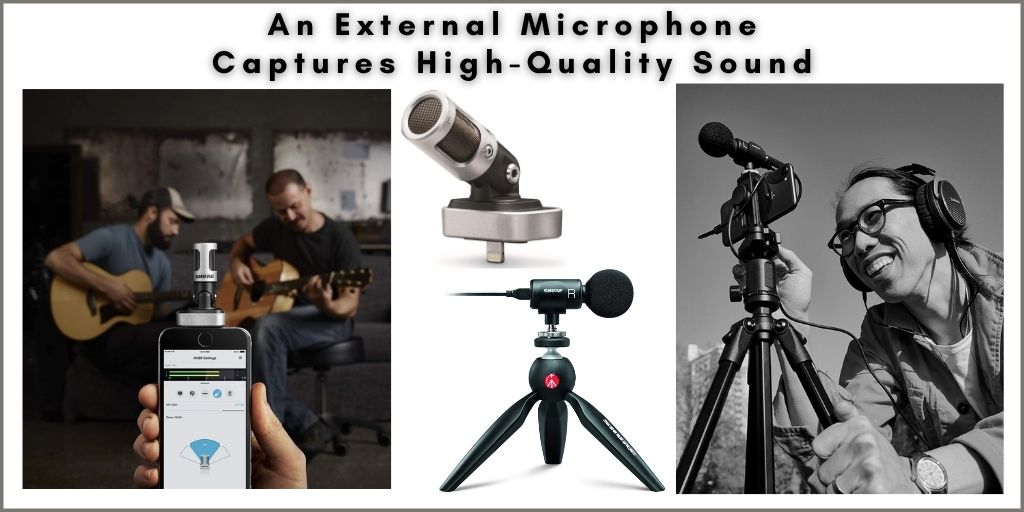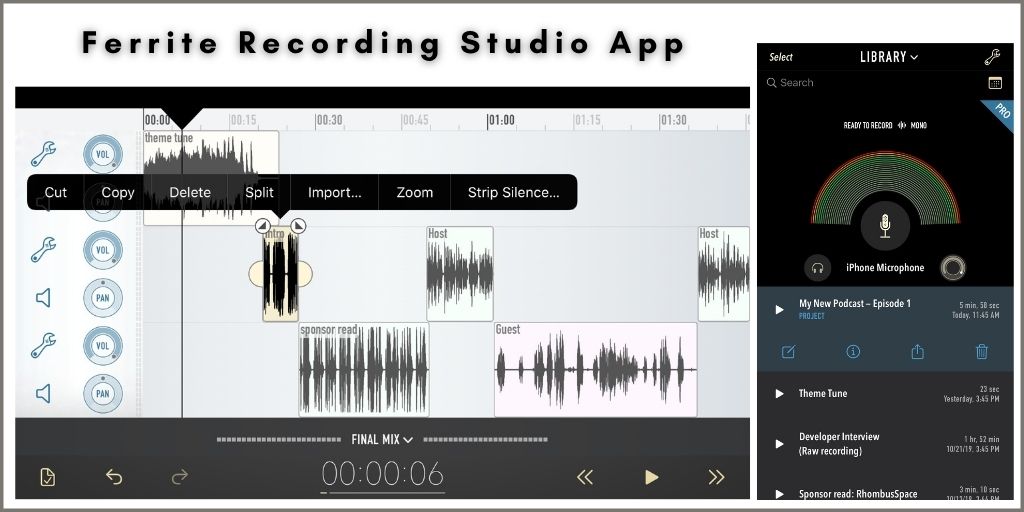A great way to liven up staying at home during this pandemic is by listening to some podcasts. There are over 100 million podcast listeners per month. Many podcasters can earn a lot from making a podcast like Joe Rogan and Dave Ramsey.
So, do you have experience in a specific subject or niche? Why not start your own podcast to grow your personal brand or company’s presence on the internet?
To create a podcast, you don’t need a fancy recording studio or a complicated setup. All you need is your iPhone or iPad and an interesting idea to talk about.
If you wonder how you can share your experience and create a podcast with an iPhone or iPad, read on to learn more on how to create a podcast and your needed podcast equipment.
Using Your iPhone or iPad to Start Podcasting
The iPhone and iPad are expensive gadgets with lots of features and plenty of processing power to record, edit, and publish high-quality podcasts. So, take advantage of its features to create your brand new podcast.
This is what you need to start podcasting using your iPhone or iPad:
- A good external microphone capable of capturing high-definition audio
- A free recording/editing app
- Some work to improve the acoustics of your recording environment
- Choose the right niche
Let’s explore each one in more detail.
External Microphone
Podcasts are all about high-quality audio. The reality is that the onboard mic of your iPhone cannot pick up high-quality audio; for that, you would need an external microphone.
Most external microphones use the old 3.5mm audio jack, but later versions of the iPhone no longer have it, so an adapter is needed. You can also get microphones that can specifically connect to an iPhone or iPad’s lightning port.
One of the best microphones you can connect to your iPhone’s lightning port is the Shure MV88 iOS Digital Stereo Condenser Microphone. It’s an Apple-certified accessory that can get cardioid, stereo, and bi-directional audio input. You can choose between five presets to get the best recording possible depending on the situation: Flat, Singing, Speech, Loud, and Acoustic Instrument.
Another excellent choice for the iPhone and the best microphone for the iPad is the Shure MV88+ with its studio-quality recording. It also comes with five presets along with two free apps, improving your experience.
The kit includes a Manfrotto PIXI tripod, phone clamp, and mount, as well as iOS and USB-C cables for next-level compatibility and connectivity. Just set up the tripod, place your phone on the clamp, connect the mic to the Lightning port, fire up the recording app, and start recording the podcast right away.
The Shure MV88+ is user-friendly and easy to use for both beginners and experienced.

Apps for Recording the Podcast on your iPhone
Your voice is the star of your podcast, and it needs to sound perfect. The Ferrite Recording Studio app is a free app with an intuitive layout. Most of its editing functions move more towards touch gestures for easy use.
Some of its features include multi-track editing, touch arrangement, and fast imports. It can immediately take away all the silent cuts in your recording, making it easier for you to edit. The only downside of Ferrite Recording Studio’s free version is it has a limited recording duration, but for beginners, it should be enough.
You can also use the included apps from Apple. GarageBand is another great app for recording and editing your podcast. It allows you to record multiple audio tracks, edit them, and export them into mp3 files.
You can also create tunes with its collection of touch instruments, loops, and a wide array of sound packs. This is perfect for creating intros, jingles, and outros that you can use on your podcast to make it more professional.

Tips on How to Create a Podcast
Podcasting is an excellent tool for building a loyal fanbase while generating leads. Creating a podcast doesn’t need those fancy setups and studios; all you need is a gadget, whether it be your iPhone or iPad. So, here are some steps you need to remember when recording with your iPhone and iPad:
Pick the Right Audience
You don’t have to direct your podcast to everyone of every age and gender. Narrow down your target audience to reach other people who have the same passion as you. A podcast made for everybody will lack personality and may come out as uninteresting.
Choose Your Niche
Before you record and create a podcast, you need to find a theme that you should stick to. It’s a common mistake for beginning podcasters not to know your genre, which is a no-no. Remember these two important questions:
- Who is the podcast directed towards?
- What is your theme?
Once you find a topic like politics, culture, or gaming, conduct a little research. Try to find a unique perspective that you can talk about relating to your theme or topic. It helps to talk about issues that differ from others to make your podcast stand out.
Plan a Podcast Format
Find a format that fits your podcast; you can choose to do the podcast alone, have a scripted story, or go with in-depth interviews. You have to find a middle ground as to how long each episode of your podcast should be. Most listeners love straight forward and informative podcast episodes.
Make sure also to have a set format for your episode formats. You can start with a teaser and intro, then end with a call-to-action and outro music. Create a habit of publishing your podcast consistently, either daily or every week, so your audience knows when to expect the next episode and prepare it.
Show Some Professionalism
It’s time to create the cover art of your podcast. Your cover art will be the first thing your audience sees and make a first impression. You need a unique cover art for your podcast to catch your audience’s eye along with your quality content.
Don’t know how to create the cover art for your podcast? Don’t worry; head over to the app store, download the “Canva” app and install it on your iPhone or iPad.
With the Canva app, you can create beautiful, creative cover art. Do you feel like you lack creativity when it comes to graphic design? Worry not; choose from the hundreds of ready to use design templates and personalize it to fit your brand. Within minutes you can have the cover for your podcast channel.
Next, you need an intro and outro that you can place in most of your podcast episodes. Remember always to tweak and edit your audio to make it sound clearer. You can also add some background music and sounds to make your podcast more interesting.
Record In A Quiet Area
There are many factors in your home that may be quite noisy such as traffic or air conditioners. Before you start setting up for your podcast, you should find a quiet place. Find an area in your house with minimal background noise.
It would be best if you record in an area with no reflective surfaces. The reflective surfaces will make your audio sound echo-y and distant. Add some carpets, pillows, and soft objects in a room to help you reduce sound reflections.
Launch to a Podcast Hosting Service
The most accessible channel for your podcast is the pre-installed Apple Podcasts. Apple Podcasts, known as iTunes before, is one of the most popular podcast hosting services. There are about 52% of people using Apple Podcasts while Spotify has 19%. You can also use services like SoundCloud to upload your podcast.
Time to submit your feed to the Apple Podcasts Connect. Wait at least 24 to 48 hours for a reply from Apple to send you confirmation. Once you receive a confirmation email, your episode will be live.
You can check your initial traction, such as downloads, ratings, and subscribers. Remember that your goal is not to generate huge numbers for your episodes but to create a loyal following.
Also, keep in mind that it can take some time to see the results when you are starting from cero. Post consistently and allow time to do its magic.
Ask for feedback from your followers to see what you can change to improve each episode, and never overlook or forget to respond to the comments. You want to be engaged with your followers to see growth.
Create A Podcast On An iPhone Or iPad
The iPhone and iPad are awesome gadgets, so take advantage of its features to create a podcast. Get the right mics, the best editing programs, and work on improving your recording environment.
Take your time planning and practicing your podcast.
If you need help finding out which products fit you the most, check our other articles as we provide extensive reviews to help you gauge which sound gear and other tools to invest in.